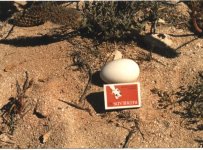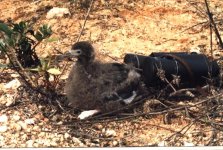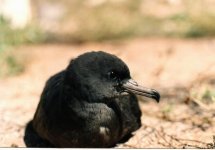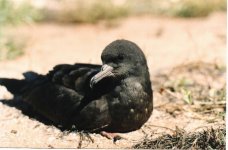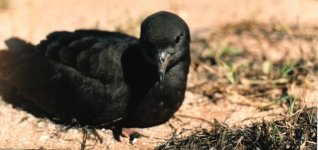WEDGE-TAILED SHEARWATER (Puffinus pacificus).
Varanus Island had three small nesting colonies and when I first heard these birds calling from their burrows in the night I was at first struck with a little bit of fear but on investigating I became very excited, especially when the birds started sweeping past me and landing on the ground at my feet. Over the years I became rather blasé with their common appearance. Each year, Harry Butler would arrive and do a count of the occupied nest burrows and overall the nesting on the Island was relatively stable, showing that the occupation of the industry didn’t adversely affect their breeding. Sadly, on a couple of occasions a tropical Cyclone would come over the island and devastate the colonies. The rain would flood the burrows and they would collapse onto the chicks or eggs within. After one of those storms I inspected the site and some youngsters were out in the open so to some Adults who had landed in the night and were still searching for their destroyed nests. This was when I was able to take the pictures below. During the day the Silver Gulls and other predator birds would arrive and kill and eat the exposed youngsters and eggs. On a moonlit night I would sit on the cliffs watching the birds fly in over the Indian Ocean and almost touch my head as they swooped in to the nesting ground.
We called this bird, The Mutton Bird, but the name applies to a variety of Shearwaters and Petrels that breed in burrows on Australian Islands. The interesting thing about these birds is that the parent’s almost force feed the chick until it’s nearly twice the weight of an adult then they fly away and the big downy chick is left for almost a month without being fed. During this time its feathers grow until eventually it too flies away. At the large fatty stage the young of the Short-tailed Shearwater is harvested for its oil and flesh. The oil is rich in Omega-3 fatty acids; the amount is such that 1gram of oil per day taken would at least double the normal daily intake.
On those, still and humid nights I would lie on the beach waiting for the Turtles to lumber up to nest and I would hear the, moaning, wailing sound of the Shearwaters from the nearby nesting ground. The nearest sound that resembles it in England are the calls of the Grey Seals that sing on the sandbank off Hilbre Island at the mouth of the River Dee.
Varanus Island had three small nesting colonies and when I first heard these birds calling from their burrows in the night I was at first struck with a little bit of fear but on investigating I became very excited, especially when the birds started sweeping past me and landing on the ground at my feet. Over the years I became rather blasé with their common appearance. Each year, Harry Butler would arrive and do a count of the occupied nest burrows and overall the nesting on the Island was relatively stable, showing that the occupation of the industry didn’t adversely affect their breeding. Sadly, on a couple of occasions a tropical Cyclone would come over the island and devastate the colonies. The rain would flood the burrows and they would collapse onto the chicks or eggs within. After one of those storms I inspected the site and some youngsters were out in the open so to some Adults who had landed in the night and were still searching for their destroyed nests. This was when I was able to take the pictures below. During the day the Silver Gulls and other predator birds would arrive and kill and eat the exposed youngsters and eggs. On a moonlit night I would sit on the cliffs watching the birds fly in over the Indian Ocean and almost touch my head as they swooped in to the nesting ground.
We called this bird, The Mutton Bird, but the name applies to a variety of Shearwaters and Petrels that breed in burrows on Australian Islands. The interesting thing about these birds is that the parent’s almost force feed the chick until it’s nearly twice the weight of an adult then they fly away and the big downy chick is left for almost a month without being fed. During this time its feathers grow until eventually it too flies away. At the large fatty stage the young of the Short-tailed Shearwater is harvested for its oil and flesh. The oil is rich in Omega-3 fatty acids; the amount is such that 1gram of oil per day taken would at least double the normal daily intake.
On those, still and humid nights I would lie on the beach waiting for the Turtles to lumber up to nest and I would hear the, moaning, wailing sound of the Shearwaters from the nearby nesting ground. The nearest sound that resembles it in England are the calls of the Grey Seals that sing on the sandbank off Hilbre Island at the mouth of the River Dee.




